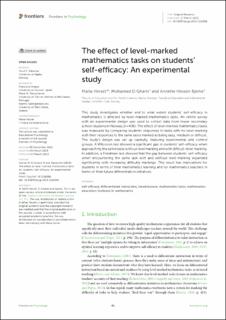| dc.contributor.author | Herset, Maria Klaussen | |
| dc.contributor.author | El Ghami, Mohamed | |
| dc.contributor.author | Bjerke, Annette Hessen | |
| dc.date.accessioned | 2023-03-21T14:40:31Z | |
| dc.date.available | 2023-03-21T14:40:31Z | |
| dc.date.created | 2023-03-20T10:06:06Z | |
| dc.date.issued | 2023 | |
| dc.identifier.citation | Herset, M., El Ghami, M., & Bjerke, A. H. (2023). The effect of level-marked mathematics tasks on students’ self-efficacy: An experimental study. Frontiers in Psychology, 14, Article 1116386. doi: | en_US |
| dc.identifier.issn | 1664-1078 | |
| dc.identifier.uri | https://hdl.handle.net/11250/3059587 | |
| dc.description.abstract | This study investigates whether and to what extent students’ self-efficacy in mathematics is affected by level-marked mathematics tasks. An online survey with an experimental design was used to collect data from lower secondary school students in Norway (n = 436). The effect of level-marked mathematics tasks was measured by comparing students’ responses to tasks with no level marking with their responses to the same tasks marked as being easy, medium or difficult. The study’s design was set up carefully, featuring experimental and control groups. A Wilcoxon test showed a significant gap in students’ self-efficacy when approaching the same tasks without level marking and with difficult-level marking. In addition, a Friedman test showed that the gap between students’ self-efficacy when encountering the same task with and without level marking expanded significantly with increasing difficulty markings. This result has implications for students in terms of their mathematics learning and for mathematics teachers in terms of their future differentiation initiatives. | en_US |
| dc.language.iso | eng | en_US |
| dc.publisher | Frontiers | en_US |
| dc.rights | Navngivelse 4.0 Internasjonal | * |
| dc.rights.uri | http://creativecommons.org/licenses/by/4.0/deed.no | * |
| dc.title | The effect of level-marked mathematics tasks on students’ self-efficacy : An experimental study | en_US |
| dc.type | Peer reviewed | en_US |
| dc.type | Journal article | en_US |
| dc.description.version | publishedVersion | en_US |
| dc.rights.holder | © 2023 The Authors | en_US |
| dc.source.pagenumber | 10 | en_US |
| dc.source.volume | 14 | en_US |
| dc.source.journal | Frontiers in Psychology | en_US |
| dc.identifier.doi | 10.3389/fpsyg.2023.1116386 | |
| dc.identifier.cristin | 2135186 | |
| dc.source.articlenumber | 1116386 | en_US |

